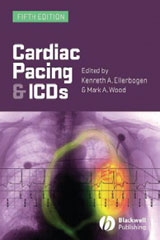Editors: Ellenbogen K, Wood M
Publisher: Wiley-Blackwell, Oxford, 2008
ISBN: 978-1-4051-6350-7
Price: £31.99
 Perhaps in common with other DGH general cardiologists, I confess to having never read a book on cardiac pacing, let alone implantable cardioverter defibrillators (ICDs). This 5th edition of Cardiac Pacing & ICDs is a thorough work. The diagrams are clear and sufficient to make this book easy on the eye and a pleasure to read. Each chapter is also very adequately and not excessively referenced.
Perhaps in common with other DGH general cardiologists, I confess to having never read a book on cardiac pacing, let alone implantable cardioverter defibrillators (ICDs). This 5th edition of Cardiac Pacing & ICDs is a thorough work. The diagrams are clear and sufficient to make this book easy on the eye and a pleasure to read. Each chapter is also very adequately and not excessively referenced.
I found the chapter on temporary pacing very applicable to my everyday experiences. Particularly useful was discussion surrounding the requirements (or not) for temporary pacing in patients undergoing non-cardiac surgery with various degrees of conduction disease. The complications and their likelihood from temporary pacing are well described. There are some interesting facts concerning the success rates, duration and failures of transcutaneous pacing. The sections on basic concepts of pacing of this book are highly detailed and would be a reference for most of us to ‘dip in and out of’ rather than read in its entirety.
Chapter 5 incorporates ‘the meat’ of permanent pacing techniques, both for implantation and removal of systems. There were good explanations of pre-procedure set up and patient preparation; the latter often not addressed in clinical practice. I liked the diagrammatic explanation for that common problem of difficulty in advancing a lead via the cephalic approach when it joins the axillary vein at an acute angle. Extra-thoracic access to the axillary vein (usually described as the subclavian vein) can avoid the complication of subclavian crush of the lead – again a common practical ‘access’ issue that we all encounter.
In the section on pacemaker pocket creation, there is, however, no mention of the timing of this. I like to make the pocket near to the start of the procedure in order to ensure that I can demonstrate haemostasis has occurred by the time I attach and place the generator in the pocket. Particularly useful for trainees will be the explanations on how to prolapse the right ventricular (RV) lead through the tricuspid valve and hence hopefully avoid entrapment in the subvalvular apparatus, inadvertent entry into the coronary sinus or RV perforation.
Following this are two chapters on programming and fault finding (pacing system malfunction). ICD implantation and the indications for their use are easy to read and succinct in chapter 8, with no repetition of similar pacemaker implantation techniques. There is within this section a good explanation of the issues encountered with left ventricular lead placement. I particularly liked the diagrammatic and text explanations of cardiac re-synchronisation therapy in chapter 9. The book finishes with two chapters encompassing the follow-up, monitoring, faultfinding and adjustments of patients with these devices.
Overall, a substantial book at 558 pages and one that has been ‘honed’ over its five editions and 13 years to produce a balanced and current text.
